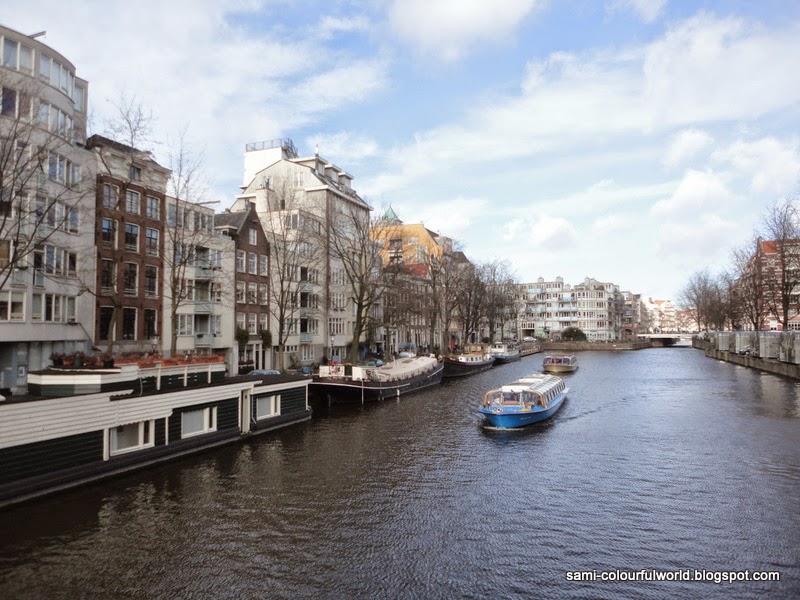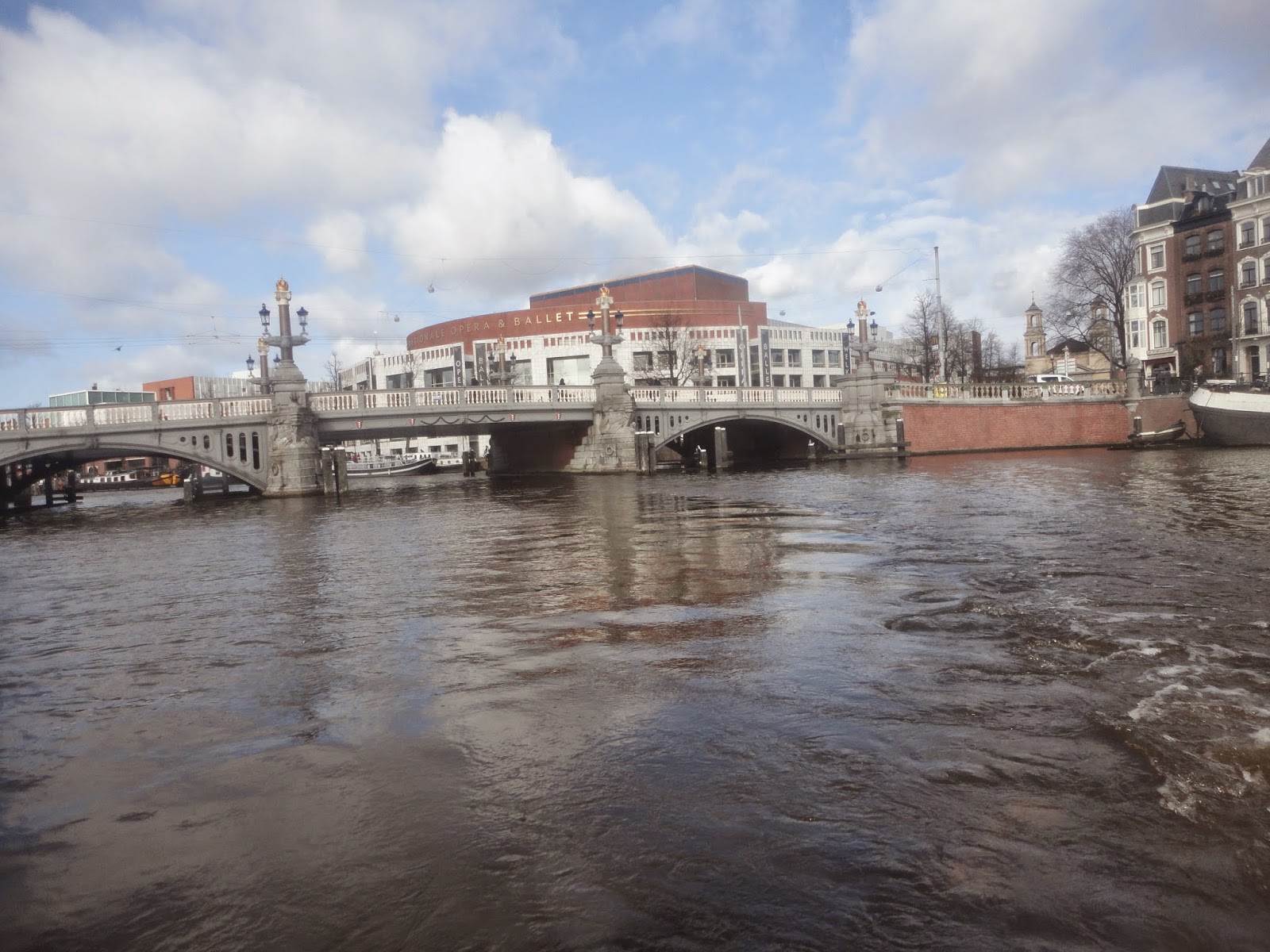Central Station is the main transport hub in the city with trains departing to other Dutch cities and other European capitals. In front of the station you can find the main stops for tram and city buses. Trams end at 1pm, after that you either ride a bike or take a taxi.
Car traffic is heavier around the Station, although bicycles still have right of passage, it can be confusing if you're not used to it, as there are cars, trams, buses, people and bicycles to be on the lookout for. There are bike lanes everywhere, and with an average of 3 bikes per resident it's no wonder it's a cyclists paradise!

Just minutes from Central Station is one of the Canals - Damrak, and we booked a Gray Line 1 hour canal cruise for 15,50 euros each. It was departing 15 minutes later so we just sat around. This line has cruises starting from 10am to 18pm and frequent intervals.
You're given disposable earphones and you can listen to the audio in one of 19 languages.
As you can see the buildings on the left are right on the canal. Some are undergoing restoration as the original wooden pylons from centuries ago are rotting away, so they need substitution.
The canal tour was interesting as it's also a way to identify things you would like to see later on at your leisure.
 Of course Amsterdam is also known for it's houseboats, so right and left in every canal you're bound to find houseboats for every taste.
Of course Amsterdam is also known for it's houseboats, so right and left in every canal you're bound to find houseboats for every taste.
 |
The EYE Museum I mentioned in my first Amsterdam post and the former Shell building being renovated into apartments
|
We went past one of the narrowest houses in Amsterdam too. The Dutch used to pay taxes on the width of their house, reason why the buildings were so narrow.
Because the stars are also narrow and steep, furniture had to be hoisted up to the apartments, so the buildings have an arm and hook sticking out for this very purpose.
 |
| A very narrow house |
 |
| The leaning buildings of Amsterdam |
 |
| The brown building leaning forward |
 |
| Herengracht canal and wide houses |
Canal tour over, we walked to the Red Light District to the east of the canal.
Of course famous for it's brothels, sex shops and window prostitutes, the Red light district is also one of the oldest areas in Amsterdam with cobbled streets, churches and old houses.
Prostitution is legal in Holland, just like soft drugs making the Dutch a very liberal and tolerant people.
I was a bit disappointed at the caliber of the ladies in the windows showing off their "wares" - they seemed to be all on the heavy side, no elegant models here! And no photos of the ladies please, not allowed!!
I heard from a tour guide talking to a crowd of youngsters that the oldest prostitute in Amsterdam was in her late seventies and she had a 2 week waiting list!!! She didn't rent one of the windows though, she worked from home.
Here you can also find a Condom shop that looked quite interesting from the window, soft drug shops and shops with Red light district souvenirs...
The few hotels I noticed here seemed to be a bit on the low end of the scale...maybe used for "monkey business" only??
 |
| Signs, soft drugs, condoms and other sex paraphernalia |
On the Oudekerplein, (Old Church Square) right across some of the windows where the ladies show their wares, is Oude Kerk (Old Church) an 800 year old church whose floor consists of gravestones, as it was built on a cemetery.
Outside the church of a statue of a prostitute called "Belle" was installed in 2007 with the sign "Respect sex workers all over the world".
 |
| Oude Kerk |
| Grave stone floor of the Oude Kerk |
 |
| Belle - statue to the Prostitute |
This statue of a hand touching a breast, found on one of the cobbled streets in the Red Light District was done and installed by an anonymous artist.
Here you can also find some interesting bars and small restaurants and boutiques in the little alleys.
We had a waffle and tea in one of the coffee shops, and of course you have to disrobe all the cold gear, and about 1 hour after we left I noticed I hadn't brought my hat (or I should say my daughter's hat) with me. So we had to retrace our steps and luckily when we asked about the missing hat they had it under the counter. Phew, I would really bad if I'd lost it!
I was amazed to find "Chips" shops - just selling chips (frites) with various toppings, the most common being mayonnaise. I can't imagine a shop surviving just selling chips, but there are various other chain stores around town, so it must be popular!
 |
| Red Light district bars and restaurants |
 |
| Small alley at Red Light District |
 |
| Wanna try chips and mayo? |
From our Canal tour, we saw the Flea Market - Waterlooplein - so we walked there, crossing two canals east of the the Red Light District.
It's not too far from Rembrandt House, and just behind the National Opera and Ballet building.
Here you can buy clothing, books, African crafts, and a lot people are selling their household junk too. Interesting if you have the time to wander around or want to bag some bargains.
 |
| Flea market stalls |
 |
| The National Opera and Ballet behind the bridge |

From the Flea Market we walked to the next quarter where we visited the 16th century Portuguese Synagogue. Being Portuguese we were curious about this part of history and we enjoyed our visit.
The entry fee of 15 euros is valid for 1 month and entitles you to visit other related museums in the Jewish Quarter - Jewish Historical Museum and National Holocaust Memorial and Jewish Children's museum - unfortunately we didn't get time to come back to any of the other museums.
You are given earphones and you can hear the commentaries in the various rooms.
Back then the Synagogue had no electricity, so night services were candlelit. There is a "museum room" where silver, books and church clothing are displayed.
 |
Entrance to the Portuguese Synagogue |
 |
| Inside the Synagogue - taken from the top floor |
 |
| Portuguese and Spanish names on these boards |
 |
| Display of silver used in church services |
 |
Before taking the tram home, we went to the "Tourism Information Centre" across Central Station to buy a 48 hour Iamsterdam city card to be started the following day.
This card entitles you to discounts or free entry to most Museums and other venues and to free public transport too, and the time starts counting when you tag into your first Museum and first transport.
The 48hour card cost 59Euros, but we estimated that it would pay itself with all the visits we had planned, and it did.
The booklet has a map of the city, which is good as the Information Centre charges 2,50 euros for a map. Otherwise you can get free maps at hotels.
Tuesday, 24 February 2015
|







Wow, Sami, what a post!
ReplyDeleteAnd in the middle of it I had to laugh and think, ahhhh you, too? What do we have with those hats! Perth-story to come some time soon on that matter!
Do cyclists behave in Amsterdam? Here - though from time to time I´m one myself - many are crazy...
Those canal houses and the canals look amazing! But houses not being straight? Uhhh.
A houseboat must be awesome, too - bet you fall asleep quickly on them.
The 70-year-old, my, bummer. But the statue and especially the hand I do like.
Braunschweig has a Frites van Holland, btw - yummy!
Awww and that bike, funny! Sounds like another great day you had!
The cyclists are very fast, so I had to be on the lookout when I wanted to turn.
DeleteI would be scared to live in one of the crooked houses, but I like the houseboats, maybe for retirement, I think they would be too small for me now.
Brilliant post Sami, so much to see in Amsterdam.. I had a few chuckles along the way.. Haha! Good girls go to heaven, bad girls to Amsterdam :) some interesting sculptures too. Bit of an eye opener I should think.
ReplyDeleteThere's always something interesting in Amsterdam, a bit shocking sometimes...
DeleteQue viagem fantástica Sami! Lindas fotos também, parabéns!!!
ReplyDeleteObrigada Monica, gostei imenso de Amesterdao, uma cidade bastante cosmopolita.
DeletePasseei por estas ruas, virtualmente! Muito bonito,mesmo no inverno! Informativo e bem documentado com fotos. Gostei imenso.
ReplyDelete